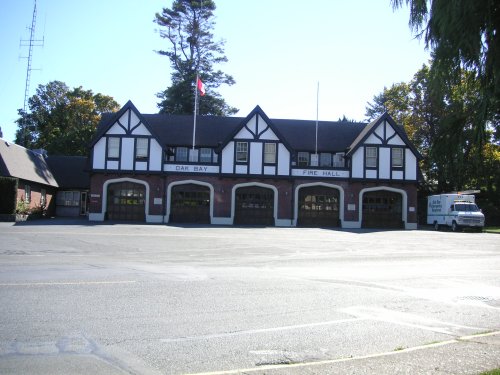1703 Monterey Avenue


The Oak Bay Fire Hall is a symmetrical, Tudor Revival style two-storey building with half timbering in the gables and a row of Tudor arched bays on the front façade. It is a prominent landmark in a residential area at the junction of Monterey Avenue and St. Ann’s Street, with large frontage, adjacent to Bowker Creek. It is located in a complex beside the Oak Bay Police Department and Scout Hut, near Fireman’s Park.
The Oak Bay Fire Hall, built in 1938, is a significant illustration of the community's pride in its built environment, and its concern for the importance of appropriate design in this residential setting. Although utilitarian in function, the building was designed by a high-profile architect, Percy Leonard James; in the Tudor Revival style frequently found in Oak Bay residences, it is entirely harmonious with its environment and is symbolic of Oak Bay. This site is only surviving municipal building by James in Oak Bay, his Municipal Hall of 1912 having been demolished; the Fire Hall has been in continuous use as a fire hall since its completion.
The heritage value of the Oak Bay Fire Hall is associated with its architects, P. L. James, and the firm Wagg and Hambleton. The original 1938 building was designed by Percy Leonard James (1878-1970). As one of the architects of the Municipal Hall (1912-demolished), St. Mary’s Church (1911-demolished) and the Oak Bay Grocery Store (1912) now part of Monterey Mews, James had proven his ability to provide civic buildings in a style suitable for Oak Bay’s residential character. He was one of the English-trained architects that profoundly influenced the direction of residential design in Victoria and Oak Bay, both separately and in partnership with his brother, Douglas, as James and James, formed in 1910. High profile residential and civic work kept the firm busy until the First World War. Their last project was for the Federal Building (1952) at the corner of Yates and Government Streets, which P. L. James completed alone; this project was renamed P. L. James Place in 1996. He was retained by the Municipality of Oak Bay for a federal housing initiative for returning veterans that was incorporated into the BC Better Housing Act of 1919. At the same time the Rattenbury and James partnership was formed to design several projects for the Pacific Railway Company. It was James’ concept to float the Crystal Garden (1921-1925) on a structural concrete raft, and his idea to use cast-stone in place of real stone for the Terminal Building (1924-1926). James was a charter member of the AIBC, and the first BC architect elected to the College of Fellows of the Royal Architectural Institute of Canada. Both organizations recognized P. L. James an Honorary Life member. The right-hand gables and two doors of the Oak Bay Fire Hall were a sensitive 1970 addition by architects Wagg and Hambleton.
The Oak Bay Fire Hall is located on the site of a former Salish First Nation's village, an important reminder of the cultural past of the area. The land was formerly a ravine the in the course of Bowker Creek, and, after the Natives left the site the Creek was diverted into a culvert, and the site filled in to provide the building land.
- setting within a residential neighbourhood across from Bowker Creek and adjacent to Fireman’s Park at the junction of St. Ann’s and Monterey Avenue
- location beside the Oak Bay Police Department
- form, scale and massing
- high pitched gable roof with three gables
- wood frame construction with concrete foundation
- style details such as brick-work in Flemish bond, stucco and half-timbering; Tudor-arched bays with glazed wooden doors; wide concrete plinth; balconies between the gables noting ‘Oak Bay’ and ‘Fire Hall’
- exterior architectural elements large open bays on ground floor, brick clad chimney stack, secondary entrances with multi-paned wood door, protective plinth blocks at the entrances to each bay
- fenestration, and window types such as: double-hung sashes with multiple panes in the upper and single lower; multi-paned transom; fixed; casement – all with wide wood surrounds
- interior features: wooden chair rail, mezzanine, custom mill-work, original brass fire pole
- landscape features: rubble wall behind the hall, mature coniferous and deciduous trees
 Instagram
Instagram
 Facebook
Facebook
 Twitter
Follow @DistrictOakBay
Twitter
Follow @DistrictOakBay